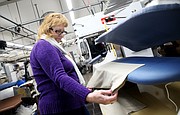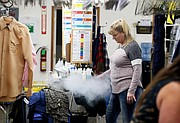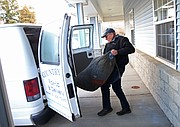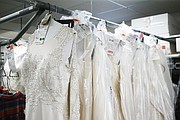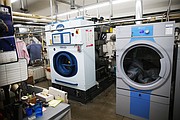Just what you needed: A good, clean business story
With its roots dating back to the ancient Greek and Roman times, dry cleaning as an industry has seen its share of changes. Grease-absorbing clays and sands were believed to be used by the Mycenaeans as long as 2,000 years ago for laundering garments.
Modern dry cleaning in America has been developing over the past 75 years, and the need to adapt with the changing times is ever present.
For the past 25 years, husband and wife team Perry and Terry Finlay have been riding the cycles of the dry cleaning business. They own and operate Country Cleaners in Hayden, and have seen the changes and embraced them through the years.
Perry got his start in the industry while a college student in Sacramento, Calif. It was 1976, and at the time he just needed a job. He found one at Swanson’s Cleaners, where he recalls learning trade secrets from some of the best and most knowledgeable people in the biz.
“I just really liked the science behind it; I found it interesting,” he said of his early days at the nation’s largest dry cleaning facility (and the world’s third largest) at the time.
“This business goes through a lot of cycles,” he said. “Just prior to me starting in the business was the polyester craze, where men wore leisure suits instead of wool suits and you could wash them at home.”
Everything became more casual, he continued, explaining how that forced a bit of a drop-off in the industry.
“But people discovered they didn’t really like washing at home. It didn’t look as good. So eventually we were able to rebound.”
Then, a few years after Finlay started in the business, “casual Fridays” became a thing. Gone were the days of the white button-down shirts, which Finlay estimated made up 98% of professionally cleaned items. He explained that eventually people started dressing for work in their “work” clothes about 20 percent less often than before, opting instead for more casual options like polos and sweaters.
“So basically, business then drops by 20 percent,” he said. “But eventually, there came the love for more natural fabrics and that’s kind of the trend we are seeing right now, which helps us out a little bit. We’ve had to replace our equipment to accommodate this.”
“We always try to stay ahead of the curve,” added Terry. “When we had to replace the [dry cleaning] machine we thoroughly researched it and decided this was the best system for us.”
That machine is part of the Sanitone system. It’s an environmentally friendly upgrade to the old perchloroethylene, or PERC, systems used in the past. Word of the cancer-causing effects of PERC use and exposure, along with the whole “green” movement, caused an aversion by some people to having items cleaned professionally.
“When you’re looking at an investment of $60,000 on a dry cleaning machine, you want to make sure you get one that will last for a while,” Perry said. “The solvent we use has been on the market for the longest time and probably has the best track record as far as being non-hazardous to people. We just knew that it was a safe bet.”
“I’ve had several people ask me, what is the solvent used and does it smell? What is the dry cleaning process? Because people don’t understand what dry cleaning actually is. I would say that is a valid selling point,” said Terry.
Recently the Finlays added a new washer and dryer to their arsenal of equipment.
“The washer has 140 different cycles on it, so we can clean just about anything. The dryer has a humidity control on it so you can even wash a wool suit and set the dryer to dry to a certain percentage and then take it out and air dry it and have a nicely done garment,” Perry explained.
But dry cleaning doesn’t stop with the clothes of the professional business person. The Finlays rarely come across any fabric they can’t clean, or at least freshen up for a customer. Items like purses and luggage, outdoor furniture cushions, cloth blinds, boat covers, sleeping bags, motor-home cushions, rugs, drapes, and even mascot costumes can be steamed, dry cleaned, washed, spotted or otherwise cleaned. They can even come to you in some instances.
The industry evolves, but one thing Perry says has never changed is learning and re-educating. He has subscriptions to three different dry cleaning periodicals. They are the same ones that he first saw on his boss’s desk back at Swanson’s in Sacramento, which he picked up and read with enthusiasm to learn as much as he could about his new trade. Today he takes the knowledge he gleans from those periodicals and shares them with his employees to help them improve their skills.
“I save them for them and go over the techniques that I’ve learned. Because I think if you don’t continue to educate yourself — I don’t care what business you’re in — you’re never gonna stay ahead of the curve. You’ve always got to strive to be number one, every day, by being more inventive every day at what you’re doing.”







